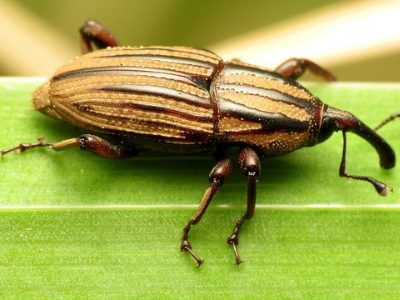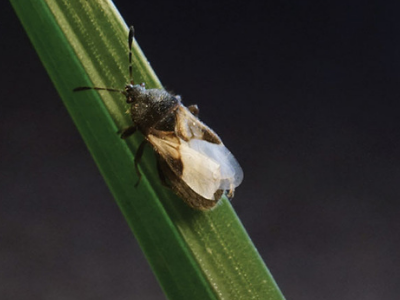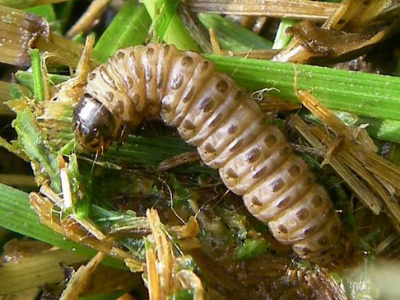
Turf Pests

Armyworm
The Fall Armyworm can take your beautiful grass down to the dirt in just a few short days. They are a common problem in Middle Tennessee and need to be treated as soon as possible. They are pale-brown to green and have longitudinal stripes running the length of their bodies. They are the larvae of Lawn Moths and usually cause damage leaving circular dead spots

Billbugs
Adult Billbugs are weevils that feed on grass stems and leaves. They are small usually around ¼- ½ inch and range in color from clay yellow to reddish bronze to black. They have an elongated mouth projecting downwards like a spout. Infestation causes patchy, dead areas or death to an extensive area. The stems of damaged turf break off easily.

Black Cutworm
Cutworms are the larvae of night-flying moths. In middle Nashville and Franklin the Black Cutworm seems to get the most attention. They are plump and can get up to 2 inches long. They appear greasy or can look wet. They lay eggs on the grass blades and feed on plant material at night. Damaged areas are often circular with dead grass and sunken spots.

Chinch Bug
Chinch Bugs are very small only about 1/6 of an inch. They have black bodies with distinct white wings with markings. A tell-tale sign is that damage to your lawn first appears as yellowish spots on the stems of your turf grass, but turns brown and dies rapidly.

Eastern Mole of Tennessee
Adult moles are 6-8 inches long with paddle-like forefeet. Moles make extensive underground runway systems. They are most abundant in spring and fall when grubs are near the surface. If you can get rid of your grubs you will likely get rid of your moles. They will move on to find food.

Fire Ant Mound
The imported fire ant can leave small or sometimes very large mounds filled with tunnels and chambers. This smothers the turf grass causing death. The chambers and tunnels can go 3-5 feet into the ground. If you see a mound forming you will need a two-step treatment to rid this pest.

Green June Beetle
The adult is around an inch or so long and has a flattened, velvety green body with bronze to yellow edges. They are active in June-August and feed on the blades of your turf grass and their larvae feeds on the roots making your grass susceptible to drought.

Japanese Beetle (Adult)
The Adult is only about ½ inch long and has a shiny, metallic-green body. Its hard outer wings are coppery-brown. These pests feed on many grasses and ornamentals in Middle Tennessee. They usually appear in May and are active for about 6 weeks.

Leafhopper
This is a small, triangular or wedge-shaped insect that fly or “hop” short distances from plant to plant consuming the stems and leaves by sucking the sap and nutrients. They are only about ¼ inch long and are green, yellow or can be brownish-grey. Damage can be severe and may appear as white patches, which can be mistaken for drought or a fungus disease.

May-June Beetle
There are several of different species that occur throughout Tennessee. These beetles are very common and often the one flying in large numbers towards an outdoor light at night. Adults like to feed on turf grasses and ornamental plants. Most adults begin emerging from the soil in May or June and lay eggs in July which hatch in August and that is another grub that feeds on the roots of your turf grass.

Pillbugs (Roly Poly)
Pillbugs are wingless, oval or slightly elongated isopods about 1/2 inch long. They are colored a slate-gray, and their body segments resemble armored plates. They look like a tiny armadillo. When disturbed the can roll up in a ball. Another nickname for this pest is Wood Lice because they are often found in and around dead wood or fallen tree branches.

Red Imported Fire Ant
This Ant builds large mounds that smother grass causing injury or death. They may also feed on any grass seed preventing germination. Their stings are painful and potentially dangerous. You will need a two-step treatment to get a good kill and eliminate this pest.

Skunk
Skunks damage turf when they dig to feed on white grubs. The sod is uprooted and damage is increased. Controlling the grub population is often the best way to prevent skunk damage. Skunks can dig to go under fencing up to 1 foot deep.

Sob Webworm
There are lots of different types of Sob Webworms in Tennessee. They are the larvae of lawn moths and they feed at night. Older larvae build tunnels made a silk and small bits of dirt and grass near the soil surface. They cut off the grass blades and eat them sometimes feeding on the crown. Damage looks like irregular brown spots and they prefer newly laid sod or new seedlings.

White Grub
By far the most important pest in turf grass in Middle Tennessee. White Grubs are the larvae of several species of beetles. Most grubs are similar in appearance. In warmer months they work their way just below the surface to feed on roots. Damage is usually in large patches and your turf can be rolled back like carpet. We have a preventative method to help reduce the number of grubs you have in your lawn.

Wireworm
These adult worms are about an inch in length and are usually hard, dark brown, smooth and slender. Wireworms bore into the underground part of the stem and feed on grass roots. The boring causes the plant and grasses to wither and die.

